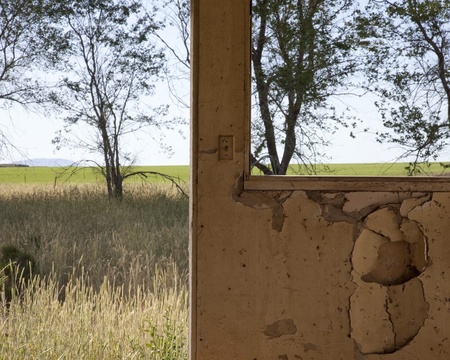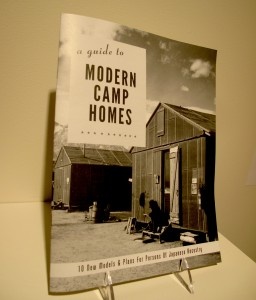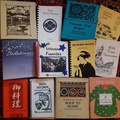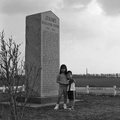Read Part 1 >>
Kevin J. Miyazaki grew up in Wisconsin, aware that his father’s family had been interned in Tule Lake and, later, Heart Mountain. On a trip to Northern California, he found himself at a museum near the Tule Lake site where, in addition to information about the internment of Japanese Americans, he discovered that, starting in 1946, many buildings that had housed internees during the War had been offered to homesteaders to resettle the area after the war’s end. These homesteaders were American veterans of WWII who participated in a lottery to work the land for an ownership stake. Buildings from the camp site were offered to lottery winners and moved to the homestead properties.
“The homesteaders had their lottery for a piece of land,” Miyazaki explains. “It was just the land, there were no roads or anything. All the infrastructure had to be built. They were given, or could buy very cheaply, these buildings. They could each have one-and-a-half buildings. They would cut them in half, put them on a flatbed truck and drive them right to their spot and drop them… They could become houses or barns or outbuildings. They are really every imaginable shape you can think of. There are also buildings that look like nothing was ever done to them; there’s still tarpaper on the sides.”
Miyazaki began to seek out the repurposed buildings and the people who lived in them. “What I’m most interested in is the houses,” he says.
“Once I realized what I was looking for, I could see the shape that you know from all the historical pictures, except that there is siding, or they may have joined them together in an L-shape or a T-shape, but it’s all the same proportion… All over the landscape there are hundreds of these buildings, so it was just me driving and knocking on doors. At first, it was a little scary. I didn’t know what to expect, but it was terrific. People were open and welcoming. I was standing in people’s kitchens talking to them.”
He later discovered that the same arrangement followed the closure of the Heart Mountain internment camp—returning veterans homesteading the surrounding area, using internment camp buildings as domiciles and work structures. He made a trip to Wyoming and repeated the process of identifying, visiting, and photographing the buildings.
The resultant photographs that comprise Camp Home are simple images of American homes and workplaces that do not, on their own, seem to exist in the context of the internment of Japanese Americans in World War II. For Miyazaki, the story of the repurposed use of internment buildings was his vehicle to engage in his personal relationship with internment.
“As an artist, I had been thinking about it and trying to make art about the internment for twenty years. I couldn’t wrap my head around how I would do that. When I discovered this story, everything kind of clicked. It makes perfect sense, given my interest in architecture and space and the element of home.”
He acknowledges, “It may not make as much sense to everybody. I’ve had people say to me, ‘You’re taking pictures of somebody else’s house.’ But I’m capturing the domesticity and the idea of home. It’s the same building… My father could have lived in any one of those buildings I was standing in. So there is this documentation of the texture of home, which I think is important.”
Also included at the Stockton Art Gallery is Miyazaki’s book, A Guide to Modern Camp Homes: 10 New Models & Plans for Persons of Japanese Ancestry.
From 1908 through 1940, Sears Roebuck & Company, like other consumer catalogues of the day, merchandised “modern” homes for sale and delivery to an expanding American middle-class consumer population. Until December 7, 1941, the West Coast Japanese American community was fully immersed in that upwardly mobile society.
“I was thinking a lot about what my family and the other families left behind. The house my father grew up in was a lovely two-story house in Tacoma. I wanted to think about this movement to camp—what they expected and what they didn’t know about moving and what they found.”
The result, Modern Camp Homes, is an “artist’s book,” essentially a mock Sears Catalogue merchandising “home” for prison-bound Japanese American internees. Miyazaki uses the upbeat language of the catalogues of the time and the burnished, positive images of internment sourced from the National Archives, including photographs by Ansel Adams and Dorothea Lange. He commissioned architectural drawings of camp structures to add to the thoroughness of the imitation and includes General DeWitt’s infamous “Instructions to All Persons of Japanese Ancestry,” as a welcoming introduction.
The result is an unsettling, sardonic compendium of an idealized version of life in the camps that underscores how much “home” the Japanese American internees irretrievably lost.
We think of photography as a medium entwined with memory. We take pictures at key moments in our personal history and view them at a later time, when they evoke recollection and emotion.
Ansel Adams, often cited as one of the greatest American photographers, went to Manzanar Relocation Center in 1943 and photographed the camp and the internees who lived there. Those photographs were gathered into a book and exhibit entitled Born Free and Equal.
In a lecture commissioned by Richard Stockton College in conjunction with this exhibit, Stephen Perloff, editor of The Photo Review and Photograph Collector declared, in spite of Adams’s best intentions, “…ultimately, his photographs of Manzanar are a failure. They fail to affect us deeply because they do not convey the truth of the dislocation and suffering the Japanese Americans suffered during their internment. As a document, it fails to get below the surface.”
Seven decades after Ansel Adams went to Manzanar, two Japanese American photographers engage the internment camps as they exist today. Miyazaki sees a different sustaining and positive life emanating from the physical foundations of the internment camps. This new life is imbued with the same values of family, hard work, and legacy that Japanese Americans lost in the camps. Yamashiro uses the remnants of the camps today to enter into a discourse with mainstream America, the mainland Japanese American community he has not known, and his own family. He engages generations past, present, and future.
Their work is honest, soul-searching, and optimistic. It affects us deeply, conveys our historical truth, and gets below the surface of imagery to mine a communal memory the artists themselves may not have known was there.
Kevin J. Miyazki’s Camp Home and Jon Yamashiro’s WWI Japanese Internment Camps will be on exhibition until Sunday, March 23. For more information, please visit the Stockton Art Gallery’s website.
*This article was originally published on JapanCulture-NYC on March 13, 2014.
© 2014 Tamio Spiegel







